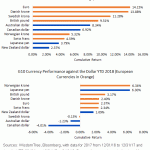In July 2015 I wrote about an unusual occurrence in markets: the fear of bonds seemed to be higher than the fear of stocks.
In the piece, I argued why this fear was irrational despite the likely low returns from a buy-and-hold bond portfolio over the coming years. Given the high valuations of U.S. equities and their overwhelmingly riskier attributes (higher volatility, higher drawdowns) as compared to bonds, the more rational fear would seem to be of equities.

Why was the fear in stocks so low? Quite simply, because they were in the midst of one of the longest runs in history without a negative rolling 6-month return. Many investors were assuming that equities were the new 6-month CD, with little need for bonds, especially when interest rates were expected to rise. (For our research on bonds, click here).
Well, fast forward to today and investors have been reminded once more why they own bonds: because stocks are not exactly risk-free instruments. In fact, they actually go down from time to time as we are seeing this year.
With the S&P 500 down 8% on the year, bonds once again are proving their place in a diversified portfolio, with the Barclays Aggregate Bond Index up close to 1%. If we look back at history, in every down year for the S&P 500 (1977, 1981, 1990, 2000-02, 2008, and 2016 YTD) over the past 40 years, the Barclays Aggregate Bond Index has been positive.

That is not to say that bonds are expected to generate a high return over the coming years. Indeed, I have argued just the opposite (see “bond math and the elephant in the room”) as interest rates remain near historic lows.

But a position in bonds allows investors to withstand equity declines and to hopefully rebalance into equities at lower prices/valuations. For investors close to retirement or in the early withdrawal stages, bonds play a more critical role as the tolerance for a near-term drawdown and higher volatility is significantly lower.














Leave A Comment